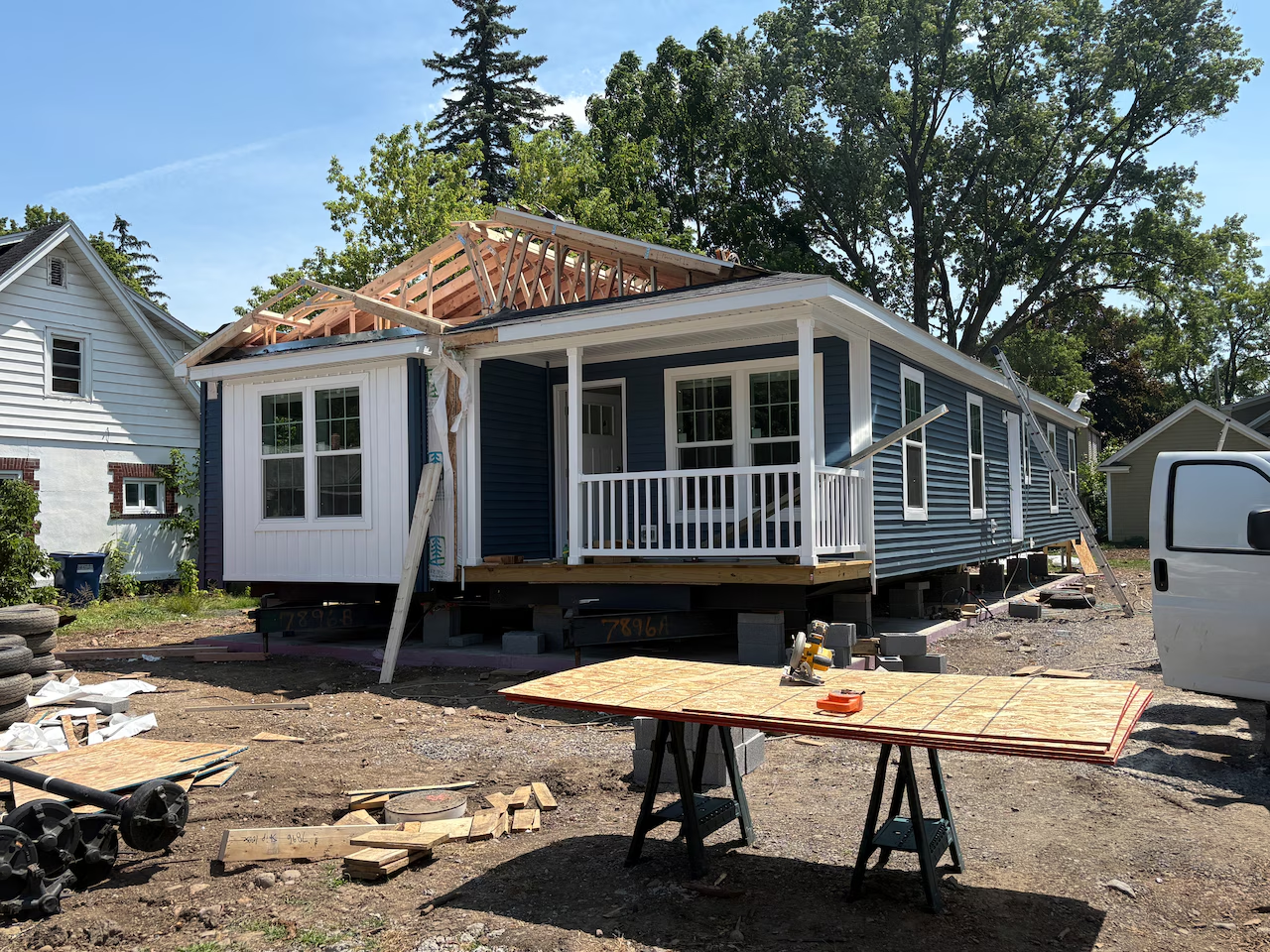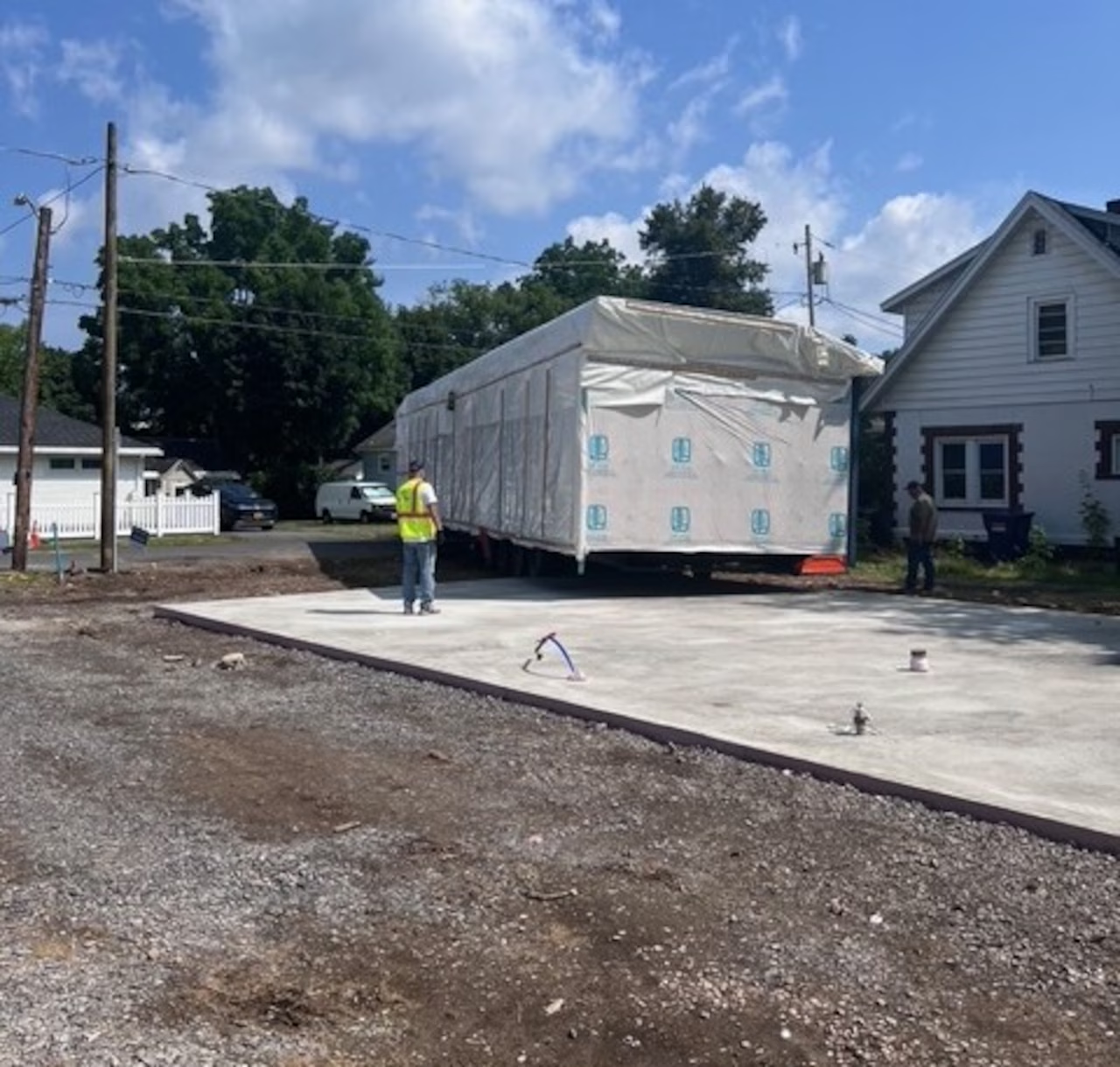Syracuse, N.Y. – The one-story home in Syracuse’s Valley neighborhood looks like a lot of starter homes. It has three bedrooms and two bathrooms, with stainless steel appliances and a small front porch.
But it was built in just two weeks for about 25% less than other new, standalone homes. Plus, it’s selling at a deep, taxpayer-funded discount meant to help qualified buyers get out of rentals and into home ownership.
And it’s an example of the kind of home state and local officials believe could be the solution to the affordable housing crisis in many communities, including Syracuse.
The house at 139 Maxwell Ave. was built in a factory in the rural town of Sangerfield, 18 miles south of Utica. It was shipped to Syracuse in two pieces in July.
Crews from Champion Homes, the manufacturer, put the two pieces together on a pre-built slab, then hooked up electrical, plumbing and water lines. According to the Greater Syracuse Land Bank, it took one week to build the home at the factory and one more week to assemble it in Syracuse.
The home, including a detached one-car garage, landscaping, paved driveway and a new sidewalk in front, cost $300,000 to manufacture and install. That’s at least $100,000 less than what most new homes in the Syracuse area cost to build.
The speed with which the house was built and its greater affordability are a potential game-changer in Upstate cities like Syracuse, where housing is in short supply and affordable housing is in even shorter supply.
And that’s before Micron Technology comes to town. The company expects to break ground this fall on a massive semiconductor fabrication plant in the Syracuse suburb of Clay. Micron’s promised job creation, along with thousands of potential spinoff jobs, are expected to bring an estimated 24,000 new households over the next two decades.
Onondaga County, meanwhile, added fewer than 1,100 new housing units in 2023, and about the same number in 2024.
Homes like the one on Maxwell Avenue could put a small dent in that need.
Move-in New York
The land bank put the starter home on sale on Tuesday for $175,000, thanks to a $125,000 subsidy from the state of New York under its MOVE-IN NY program. Buyers who meet income limitation requirements can apply to purchase the home through the land bank’s website.
The $50 million program, proposed by Gov. Kathy Hochul and part of the 2025-26 state budget, is designed to support the construction of 200 factory-built starter homes statewide. State officials said they will seek to work with communities with a high volume of residentially zoned vacant land and localities where affordable homeownership opportunities are out of reach for many people.
The hope is that manufactured starter homes can help communities like Syracuse solve their affordable housing crisis.
In recent years, construction costs, materials and interest rates have increased dramatically, driving the cost of new homes in Central New York to $450,000 or more.
Unlike conventionally built homes, manufactured homes are built in factories, where they are immune to weather delays during construction. Then they are shipped on wheels, usually in two pieces, and assembled on site.

They can be built quickly and economically, at a large scale, state officials say. They resemble traditional single-family homes and can be integrated into all types of housing markets, including urban, suburban and rural communities, they say.
Three model homes were built as a pilot for the state program — one in Syracuse and the others in Schenectady and the Adirondack town of Newcomb. They were built by Titan Homes, a division of Champion Homes, but the state is seeking more manufacturers to join the program.
What’s on the inside
The home in Syracuse has 1,500 square feet of living area and comes with a seven-year warranty.
It features an open-concept design, with an eat-in kitchen with island, a mud room with laundry, and central air conditioning. The detached garage has a subpanel for potential EV charging.
The home has laminate countertops. Its vinyl flooring has the appearance of tiling. The three bedrooms are at the back of the house, with the master suite having its own bathroom.
“You’d never know it’s not a stick-built home,” land bank Executive Director Katelyn Wright said.
Being built on a slab, the home has no basement. It also has no attic storage space. But the detached garage can be used for storage, Wright said.
She said future models the land bank hopes to sell may have steeper roofs that provide attic storage space.

Manufactured homes are built to the federal Department of Housing and Urban Development’s manufactured home construction and safety standards code and meet design guidelines approved by Fannie Mae and Freddie Mac, which allows homeowners to access conventional mortgages.
Champion says its builds 400 to 500 homes a year at its Sangerfield facility. Each undergoes a rigorous quality control review throughout the manufacturing process, as well as a third-party inspection before it is delivered to ensure all code requirements are met, it says.
The company says its homes take four to five days to build, an average of 12 weeks faster than site-built homes, allowing families to move in faster and reducing costs for builders.
Champion has been building homes for 70 years and its Titan division in Sangerfield has been building them for more than 50 years. The company employs 140 people in Sangerfield.
‘I expect significant demand’
Wright said the home is ideal for young families looking for a starter home and for seniors who want single-story living because they do not want to or cannot go up and down stairs.
“I expect significant demand,” she said. “We think there is a ton of demand.”
Buyers must have family incomes at or below 90% of the area median income, which ranges from about $65,000 for a family of one to $93,000 for a family of four.
Under the terms of the MOVE-IN NY program, the house is priced so that a family will spend no more than 30% of its monthly income on mortgage, property taxes and utility payments, Wright said.
Buyers must be owner-occupants. If the home is sold within 10 years, the new buyers must also be owner occupants, must meet the same income limitation threshold (updated for the year it is sold), and the price must meet the same affordability requirement.
The model home on Maxwell Avenue is the first newly constructed home the land bank has put up for sale. But Wright said the organization plans to apply to the state to purchase and install 60 more manufactured homes under the MOVE-IN NY program.
The land bank can only put the manufactured homes on vacant lots that are at least 48 feet wide. Wright said the organization will also look to put them in neighborhoods where there are other single-story homes, so they fit in.
It hopes to be able to offer several different home designs, she said.
The land bank is a not-for-profit organization created by the city to put vacant and abandoned properties foreclosed on by the city back into productive use.
It typically sells dilapidated homes to buyers who agree to renovate them. However, Wright said many potential buyers do not have the know-how to fix up homes. For them, new, affordable manufactured homes offer a ready-to-move-in solution, she said.
“A lot of our homes are fixer-uppers,” she said. “They’re rough. I’m excited about this program because people don’t have to deal with that hassle.”
For now, at least, the program will require ongoing subsidies from the state to make the numbers work in Syracuse.
Due to property values in the Valley, the home on Maxwell Avenue has been appraised at $250,000, even though it cost $300,000 to build and install.
“No private builder is going to do this now, but we hope the gap will shrink to the point where we do have private builders working in the city,” she said.
If you purchase a product or register for an account through a link on our site, we may receive compensation. By using this site, you consent to our User Agreement and agree that your clicks, interactions, and personal information may be collected, recorded, and/or stored by us and social media and other third-party partners in accordance with our Privacy Policy.
